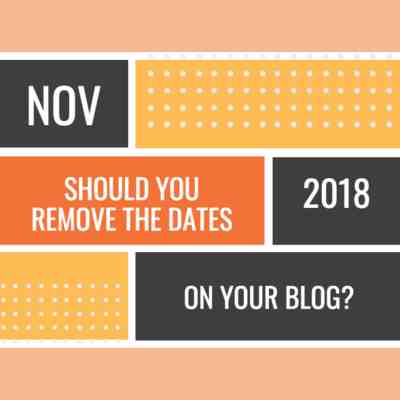Have you ever researched a big purchase or project and spent hours researching online only to realize that the information is out of date and irrelevant? If you’re like most Americans, you spend a good deal of time researching online before making a major decision. Chances are, you look at a blog post’s publish date to see if the information is relevant. This phenomenon, coupled with the rise of SEO and algorithms, has led to a debate among bloggers about whether or not to include publish dates on blog posts. There seems to be a fairly even split among professional opinions on whether or not you should or should not. In most debates, it comes down to two perspectives: the reader’s and the content producer’s.
SEOs, Relevancy, and Algorithms: Content Producers
One of the biggest arguments for removing blog dates is that they seem to hurt your blog’s chances of being seen in searches. The research is hard to ignore. Many recent algorithm changes implemented by major search engines will automatically weed out certain articles that have a date that’s considered too old to be relevant. And while some information is inherently dated, many articles have information that will be timeless to your audience (such as evergreen content), and this content may suffer from having published dates.
Additionally, it seems that every person or industry has a different limit to what they consider a ‘relevant’ blog post. Some won’t pay attention to an article older than a week. Others will still read articles that are years old. We don’t want our readers to bounce away from our content that may still be relevant to them because of some arbitrary date at the bottom on our post. Even though a post may be older, if it’s well-written and contains relevant information, it may still be helpful to your readers. And you don’t want them to miss out.
Whether it’s personal bias or algorithms, you don’t want your content ruled out before it’s given a chance. Removing dates on your posts can help make sure that your blog post will not only be seen by more people, but also ensure those people don’t attach a negative biased to your content.
Transparency: What Readers are Looking for
On the other hand, content that is relevant will ring true for an extended period. It will speak for itself. Many readers will be able to decide whether or not the information contained in your content can outlive its date.
The truth is, information can change. We have no way to predict what new discoveries or research is just around the corner. We may write an article on the technology available in your field at the time, and the next week an advancement is unveiled that renders your article irrelevant. There isn’t anything wrong with your previous material, per se. It’s just that if someone is looking for information on the latest technology, your article is no longer the best source.
If you don’t have dates on your articles, then whoever is reading your content may not know that the information is no longer salient. When you provide dates on your content, you’re expressing trust to your audience. You’re helping strengthen your relationship with your readers and showing them that you trust that they can use reasoning and context clues to know whether or not your article will be relevant to their interests. And content that is well researched and well written will hold up through time – barring any new developments.
The Power of Trusting Your Readers
Is there a way to balance the two perspectives? Is there a way you can be cognizant of SEOs and make sure that your posts aren’t weeded out by tough algorithms and still have transparency with your readers – and trust them to decide which articles are relevant to them?
An answer that many have come up with is pretty simple. You can use both posted dates and updated dates. Many find that putting dates will ultimately help build trust with their readers. For content that is popular and frequently re-shared, they’ll use a date for when the article was updated. This shows that you’re frequently updating and checking on your content to ensure it’s salient, and establish yourself as an authority in your field.
Having an updated time-stamp in addition to a published date will help ensure that your content will still be seen in major search engine results – and you will be trusted by your readers. Your relevant content will still be seen and won’t be weeded out by arbitrary metrics.
Updating dates can alleviate some of the common drawbacks to using time stamps, such as increasing how often your posts show up in algorithms and increasing audience trust. Yet, it’s not a complete workaround. Not including dates can still increase how often it shows up in searches and can reduce reader bias. The true test for whether or not to use dates on your blog, is to test it out with your particular audience, weigh your options, and decide what is best for you and your brand.















